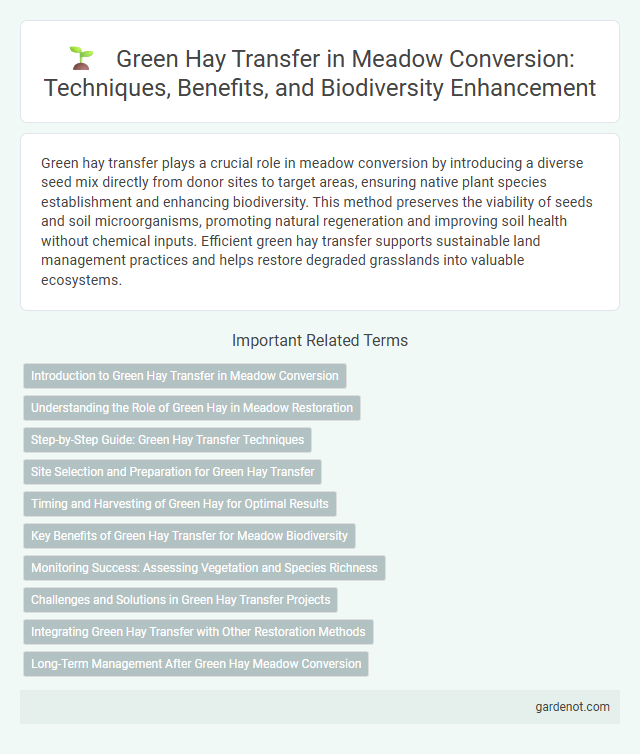Green hay transfer plays a crucial role in meadow conversion by introducing a diverse seed mix directly from donor sites to target areas, ensuring native plant species establishment and enhancing biodiversity. This method preserves the viability of seeds and soil microorganisms, promoting natural regeneration and improving soil health without chemical inputs. Efficient green hay transfer supports sustainable land management practices and helps restore degraded grasslands into valuable ecosystems.
Introduction to Green Hay Transfer in Meadow Conversion
Green hay transfer is a practical method in meadow conversion that involves cutting and immediately spreading fresh, species-rich green hay from a donor site to a target area to restore biodiversity. This technique efficiently transfers a diverse seed bank and soil microorganisms, promoting the establishment of native plant communities without the need for sowing commercial seeds. Applying green hay transfer enhances habitat connectivity and supports the sustainable restoration of species-rich meadows.
Understanding the Role of Green Hay in Meadow Restoration
Green hay transfer plays a crucial role in meadow restoration by introducing a diverse seed bank directly from healthy donor meadows, ensuring the establishment of native plant species adapted to local conditions. This method enhances biodiversity and accelerates ecological succession compared to solely relying on seed sowing or natural regeneration. By transferring freshly cut green hay rich in viable seeds and soil microorganisms, restoration practitioners can effectively restore meadow structure and function while preserving genetic diversity.
Step-by-Step Guide: Green Hay Transfer Techniques
Green hay transfer involves harvesting fresh, nutrient-rich meadow grass and immediately spreading it onto the target site to introduce diverse native seeds effectively. Key techniques include timing the cut when seed maturity peaks, carefully transporting the green hay to prevent seed loss, and evenly distributing it over prepared soil to maximize seed-to-soil contact for optimal germination. Managing moisture and minimizing disturbance after spreading enhance seed establishment and meadow conversion success.
Site Selection and Preparation for Green Hay Transfer
Site selection for green hay transfer requires identifying meadows with high botanical diversity and minimal invasive species to maximize successful colonization. Preparing the site involves removing existing vegetation through mowing or light disturbance, ensuring a receptive seedbed that promotes seed-to-soil contact and supports germination. Optimal timing aligns with the donor meadow's seed maturity to preserve seed viability during transfer, enhancing establishment of target species.
Timing and Harvesting of Green Hay for Optimal Results
Harvesting green hay at the flowering stage of native grasses ensures the highest seed viability and nutrient content for successful meadow conversion. Timing the cut just before full seed maturation maximizes seed transfer while maintaining forage quality. Rapid transport and broadcasting of green hay to the recipient site preserve seed germination potential and promote effective meadow establishment.
Key Benefits of Green Hay Transfer for Meadow Biodiversity
Green hay transfer enhances meadow biodiversity by introducing a diverse range of native plant species directly from donor sites, ensuring the preservation of local genetic variation. This method boosts soil health and promotes the establishment of rare and specialist flora, which supports a wider array of pollinators and insects. By mimicking natural seed dispersal, green hay transfer creates resilient, species-rich habitats critical for ecosystem stability and long-term conservation.
Monitoring Success: Assessing Vegetation and Species Richness
Green hay transfer enhances meadow restoration by depositing a diverse seed bank that boosts species richness and vegetation structure. Monitoring success involves systematic surveys of plant composition, abundance, and diversity indices at regular intervals post-transfer. High species richness and balanced vegetation layers indicate effective establishment and long-term ecosystem recovery.
Challenges and Solutions in Green Hay Transfer Projects
Green hay transfer projects face challenges such as maintaining seed viability during transport, preventing desiccation, and ensuring soil compatibility at the recipient site to promote successful meadow restoration. Effective solutions include timely harvesting at peak seed maturity, using moisture-retentive packaging to protect seeds, and conducting thorough site assessments to match soil conditions and optimize germination rates. Employing adaptive management practices and monitoring post-transfer vegetation dynamics further enhances restoration success and biodiversity outcomes.
Integrating Green Hay Transfer with Other Restoration Methods
Green hay transfer enhances meadow conversion by delivering native seeds and soil microorganisms directly to restoration sites, promoting biodiversity and accelerating vegetation establishment. Integrating green hay transfer with techniques such as plug planting or seed broadcasting improves species diversity and ecological resilience, creating more stable and functional meadow ecosystems. Combining these methods optimizes the restoration process by leveraging the strengths of each approach to recreate natural plant communities effectively.
Long-Term Management After Green Hay Meadow Conversion
Long-term management after green hay meadow conversion involves maintaining species diversity through periodic mowing and controlled grazing to prevent nutrient buildup and invasive species dominance. Applying rotational hay cutting schedules supports the establishment of target native plants by mimicking natural disturbance regimes. Consistent monitoring of soil fertility and vegetation composition ensures the meadow's ecological integrity and resilience over time.
Green hay transfer Infographic

 gardenot.com
gardenot.com